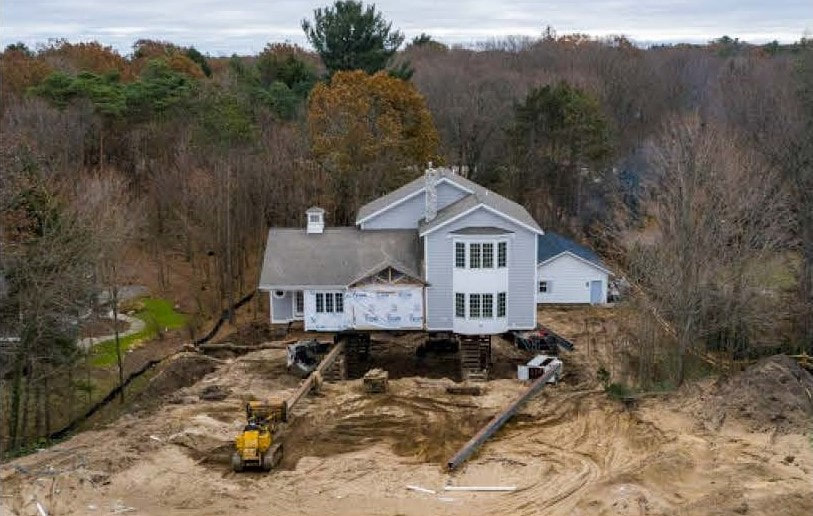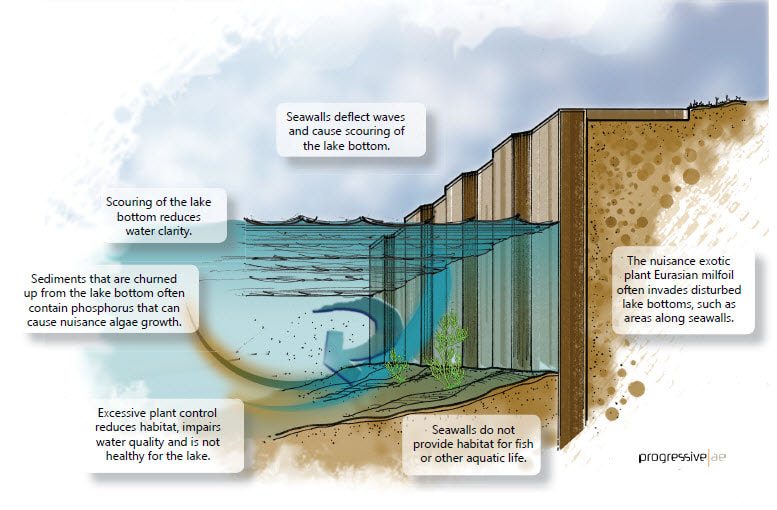When existing shoreline homes are threatened by high water and erosion, the costs and benefits of moving the structure back from the lakeshore should be weighed along with other alternatives. Moving a home back can compare favorably to other alternatives and prove to be economically, environmentally, and aesthetically better in the long run.
How do you move a house?
In the most simple of explanations, moving a house is a four-part process:
1. Site preparation for the new location
2. Building preparation
3. The move
4. Setting the home in its new location
What does the process of moving a house look like?
Before the big move, there’s a punch list of items for the professionals, but the homeowner can leave the house’s contents alone. To begin the project, the homeowner will need to work with a general contractor. The general contractor will help with site and building preparation and other aspects of the move including obtaining permits, disconnecting and reconnecting utilities, excavation, and laying the new foundation. The utilities must be shut off and disconnected from the house, including electric, water, sewer/septic, gas, telephone, cable, etc.
Depending on the size and shape of a home, the actual moving of the structure can be completed within a day or two. If the situation is dire for a property owner, the home can be moved before the new foundation is laid, although this will increase the cost. Digging the hole for the foundation in advance could decrease the cost, but it depends on how long it takes to get the foundation poured. Homes can be moved back on the same lot or if there is not enough room, houses can be relocated to a new lot.
How much does moving a house cost?
As you might imagine, moving a house is not a “flat fee” type of service. There are many factors that go into the pricing of a home move, including square-footage, as well as the structure’s length, width, weight, and construction method (modular vs. stick built, etc.). Accessibility, move distance, and other obstacles (e.g., power lines, accessibility, structural integrity) also factor into the cost to move a home or building. Garages, additions, porches, decks, balconies, chimneys, fireplaces, and other accessories can almost always be moved with the house, but add time and increase the project cost.
The total cost of moving a home ranges from as little as $12,000 for a ranch up to $100,000, or potentially more, for larger more complex sites. On average, costs for the industry seem to land between $12 and $16 per square foot.
For property owners located on islands, such as Beaver Island, there may be increased costs due to getting the necessary equipment to the island, if there is not a contractor on the island available. To reduce costs, it is recommended to work with neighbors and other shoreline property owners on the island to coordinate moving back homes. Bringing equipment over to the island for multiple jobs will defray the costs for all parties.
The Michigan Department of Environment, Great Lakes, and Energy (EGLE) compiled a small list of home movers that work in the State of Michigan. This list is not comprehensive and listing or omission of a company does not imply endorsement or disapproval. Neither EGLE nor Tip of the Mitt Watershed Council makes any endorsement or representation of any qualifications by any of the listed individuals or companies.
How do I get a quote on the cost of moving my house?
One local house mover in Northern Michigan is J&R Building Movers, located in Petoskey. To get a quote, email pictures of your house from all sides, as well as a photo from the distance showing the lay of the land, and information about the house, including dimensions and address to jandrbuildingmovers@outlook.com.
An initial estimate can be provided and then J&R Building Movers will schedule a time to conduct a site visit to the property. A site visit costs $500. The $500 will be deducted from the overall price of moving the house, should you choose to contact with J&R Building Movers.
Moving structures away from eroding shorelines is a longer-term solution than installing and maintaining shoreline protection. Shoreline armoring can adversely affect the health of the Great Lakes as well as neighboring properties. As waves hit the large boulders or concrete seawalls, the energy from the waves does not disappear. This energy is directed downwards and sideways. The energy that is directed down erodes the lake bottom. Scouring of the lake bottom increases with lake size and wave height, causing a loss of habitat. In addition, seawalls cause wave flanking in which the wave energy is also deflected sideways to neighboring property. This causes erosion on your neighbor’s property where there might not have been any erosion.
Hardening the shoreline, through riprap or revetments, can alter sand movement and water currents. Because shore parallel structures prevent some exchange or movement of sand in a local area, depending on the positioning of the wall, the beach in front of that structure may actually be narrower. That is a result of greater reflection of the wave off the structure. There may also be additional starvation of the beach downdrift of the structure.
Furthermore, once a bluff or beach is reinforced, it is an ongoing financial investment to maintaining the structure, which will be battered and worn down by the lake over time.
It is also important to note, a homeowner is responsible for any damage caused to neighboring properties from their individual actions. So if a seawall or riprap is installed incorrectly or fails and causes erosion of your neighbor’s property, you are civilly liable for the damages your actions caused. In addition, any property owner whose house does fall into the lake is responsible for cleaning up all debris.
In the long-term, moving a house can often be better for your pocket book, your neighbors, and the Great Lakes.




